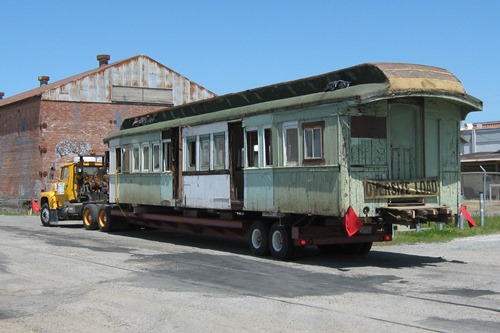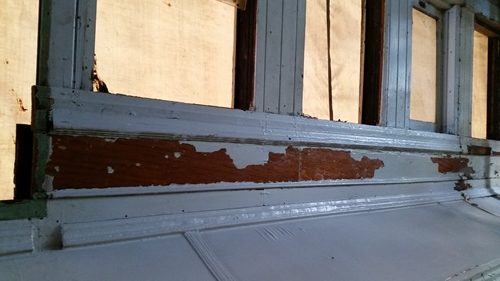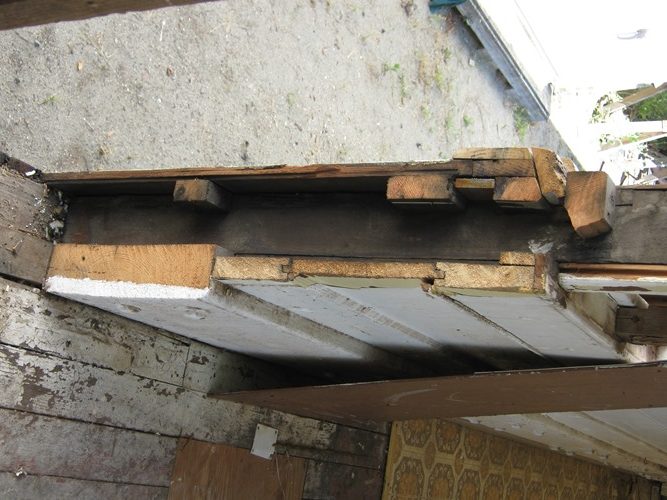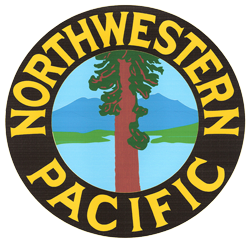From The Headlight September – October 2015
Central Pacific 29
Of Doorways and Truss Rods
By Mike Manson
Now that P&SR Caboose 1 is completed, and work is progressing on NWP Baggage 605, CP 29 must be made ready for restoration work to proceed. A general cleanup of CP 29’s interior was done during the last couple of months. “Stuff” had accumulated in the car since its arrival in Petaluma: several wooden chairs, a small desk, lots of nuts and bolts, four storage shelves and tools.
The car had also served as a storage facility for Baggage 605’s wood siding purchased with funds from the Buy-A-Board Campaign. But now the siding is where it belongs, hanging on the exterior wall of the baggage car.
Back in April 2012 the Society was offered 188 board feet of 1¼” pattern-grade mahogany planks. We purchased them for use in the restoration of CP 29. These planks had been kept inside the car since then. At the beginning of August, they were moved into the yellow barn at the De Carli Trolley Museum. With the siding and the mahogany planks out of the car, and the remaining materials organized the Restoration Team will have better access around the car’s interior.
Some of the interior paint is flaking off the underlying varnished wood. Scraping the paint with a knife has sped up the process on one of the planks above the windows, but the Speed Heater lamp will be used for most of the work.
The west side of the car must be repaired where two doorways were cut into the wall. At each doorway the truss plank and the inverted body truss rod were cut out. The inverted body truss rod extends horizontally along the side wall beneath the windows, from one corner post to the other. It dips down at the ends to support the car floor. A truss plank is a 3″x12″ beam that is located inside the car at the base of each side wall; it too extends from corner post to corner post. The truss planks are set on edge onto floor boards that in turn are set upon the side sills. The truss planks are bolted horizontally to the window posts and vertically to the side sill.
Beneath CP 29 the two truss rods and their supporting queen posts were cut away when the car was detrucked. The truss rods extended beneath the car from end to end, pushing up against the queen posts, which pushed in turn upward against the needle beams. The needle beams pushed upward against the car floor assembly.
CP 29 as it sits on support beams is not level. A preliminary survey indicates that the car’s south end is two inches lower than its north end. Whether the dropped end is due to damaged truss rods or a difference in elevation of the support beams is not yet known.
To eliminate the potential for creating a permanent distortion in the car when the damaged areas are repaired, CP 29 will be leveled using screw jacks at several locations on both sides of the car floor. The jacks will be set at both ends, the mid-point of the car, and beneath the cut-out areas. Once the car is leveled the inverted truss rod will be welded and the spring plank repaired. Eventually the queen posts obtained from B&O 20 will be bolted to the needle beams, and 20’s truss rods will be welded into position under 29. The Restoration Team is planning to install a steel channel beam to connect the two coupler pockets and support the car floor, just as we did with Caboose 1. The combination of truss rods, inverted truss rods and steel channel beam should keep CP 29 as straight as the day it left the Wason factory.
After the car is leveled the interior paneling will be removed from the west wall to repair the inverted truss rod and spring plank and replace the missing window posts. New planer blades will be cut to match the existing board profiles, then some of the mahogany planks will be milled to replace missing or damaged trim boards. We are still looking for a passenger car version of a Morris journal box to replace the box destroyed in the roundhouse disaster in Baltimore. Also, a conductor’s valve and pressure gauge are needed. If you can locate or donate these items, please contact the author at mike_mnsn@yahoo.com.
CP 29 needs donations to our “Buy a Pound of Pedestal” campaign. Each donation of $10 will cover the prorated cost of the patterns, steel, sales tax, energy and labor needed to cast one pound of a pedestal for CP 29 and bring it to the De Carli Trolley Museum. One donation of $30 came in this last month, so three more pounds of pedestal have been funded. Please send your donation today.




